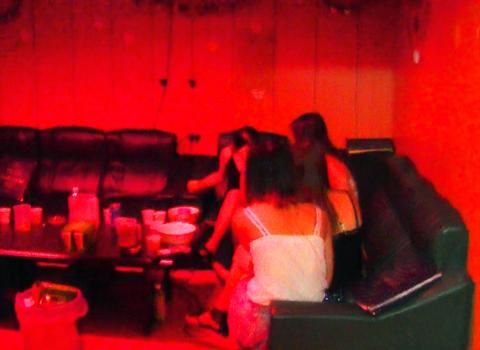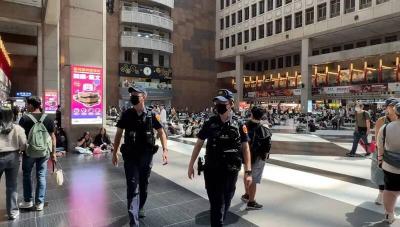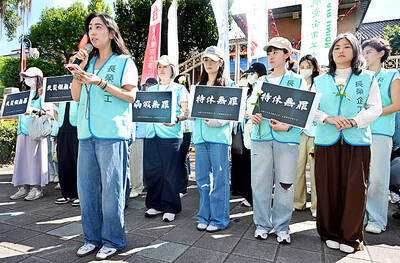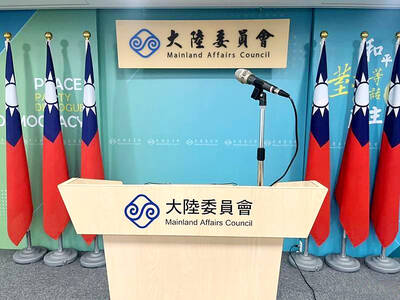Nearly a month after Taiwan amended a law legalizing prostitution by allowing cities and counties to establish designated red light districts, local governments have shown little interest in establishing such zones in their areas.
Under the Social Order and Maintenance Act (社會秩序維護法) amended on Nov. 6, prostitution is now legal in areas zoned as red light districts, but illegal outside those areas.
Customers and prostitutes caught outside the zones face fines ranging from NT$1,500 to NT$30,000, as opposed to previously when legal zones could not be set up and only sex workers were fined and not their clients.

Photo: Liberty Times
Despite the lifting of restrictions, the five special municipalities and 17 counties and cities throughout Taiwan are uneasy about setting up red light districts, with many citing a lack of public support.
The only exception is Keelung Mayor Chang Tong-rong (張通榮), who has shown interest in doing so to attract tourism and boost the local economy.
Meanwhile, many people are questioning whether red light districts would be able to resolve long-existing problems in the nation’s sex industry and improve the safety and livelihood of sex workers.
Even groups that support decriminalizing prostitution have proposed very different methods of supervising the sex industry.
The Collective of Sex Workers and Supporters (COSWAS), which has been fighting for the rights, recognition and legalization of sex workers for 14 years, is in favor of allowing red light districts to be set up in business districts and decriminalizing both prostitutes and clients.
The group basically supports following Australia’s prostitution laws, COSWAS secretary Wu Jo-ying (吳若瑩) said.
In Australia, prostitution in general is legal, but regulations vary among states. Street prostitution is illegal in most states as long as brothels have permits, but in New South Wales, street prostitution is allowed as long as it is kept out of view of schools, hospitals and churches. A few states, such as Queensland, allow one-woman brothels.
“We’re in favor of the Australian model because it includes the opinions of sex workers … and opens up discussion with neighborhood residents,” Wu said. “Residents can oppose on a non-moral basis, such as parking problems, but the model rules out objections based on moral values.”
Australia’s laws are so detailed that they govern the appearance of the shop, how ads should be written and what kind of doors need to be installed, so the industry can keep a low profile and not upset neighboring residents, Wu said.
However, another COSWAS official said there are problems that would need to be addressed, including the monopolization of the zone by certain sex industry providers, limitations placed on the age and appearance of women working in the zone and whether the privacy of sex workers could be protected if Taiwan were to legalize the trade.
Another concern is that legalizing prostitution would lead to an influx of foreign sex workers and potentially a spike in the trafficking in women.
A study in 2008 by the European Network for HIV/STI Prevention and Health Promotion among Migrant Sex Workers said up to 70 percent of sex workers in the Netherlands’ red light districts were foreigners, mostly from neighboring European countries and countries in Africa.
The Garden of Hope Foundation, another Taiwanese organization that helps girls and women leaving the sex industry, said a surge in sex workers from Southeast Asia is exactly what they fear. It said it has received inquiries from the American Institute in Taiwan about the danger of an increase in the number of human trafficking victims.
“[The US] has been pressuring the National Immigration Agency, warning that if Taiwan legalizes red light districts, it would become a hub for sex workers from Southeast Asia,” foundation chief executive officer Chi Hui-jung (紀惠容) said.
The foundation is in favor of the Swedish model, which decriminalizes sex workers, but heavily penalizes patrons — up to a maximum of six months in prison — Chi said.
Swedish prostitution laws have proven to be effective in reducing the size of the industry, Chi said, adding that it has also reduced instances of sex trafficking.
Her group does not support the establishment of red light districts because doing so does not follow international trends, she said.
The Netherlands, for instance, plans to gradually shut down a quarter of the shops in Amsterdam’s red light district by next year, while Rotterdam plans to shut down its district completely, because they have found a lot of the workers in the zones are victims of trafficking, Chi said.
She said that Australia’s prostitution laws probably would not work in Taiwan because of the overt conservative attitude of Taiwanese toward sex and the lack of support for red light districts being set up in residential neighborhoods.
“A recent survey conducted by the government showed that 75 percent of Taiwanese support the sex industry, but when it comes to setting up red light districts in their neighborhoods, 100 percent said ‘no,’” Chi said.
Despite supporting different approaches to decriminalizing prostitutes, both COSWAS and the foundation agree that a main reason why many women wind up in the industry is because of economic need: Most of them are from socially disadvantaged families burdened with debt.
“The problem with the sex industry is it is based on structural inequalities,” Chi said. “Many sex workers might have been physically abused at home, economically disadvantaged or come from single-parent families. They might have learning difficulties and were expelled from school and when they enter the job market, they end up in the adult entertainment sector because they do not have any professional skills.”
Women from these socially disadvantaged backgrounds are more likely than others to be pressured into working in the sex industry, she said. Since they have little choice in entering this industry, they should not be criminalized, she added.
Chi said the foundation hopes to reduce the scale of the sex industry by providing an exit strategy for these women.
However, many social support applications restrict the type of people who can apply, discriminating against young single mothers. There are no educational subsidies for these young girls, giving them few options but to work in the sex industry, Chi said.
Two to three decades ago, many sex workers in Taiwan were girls from economically disadvantaged Aboriginal tribes, Chi said.
Their families were tricked into thinking their children were going to get jobs and signed contracts to sell their children for about NT$300,000, she said.
Chi said the trend has changed somewhat over recent years, with an increasing number of underaged sex workers from urban areas, such as runaways, junior high and high school dropouts, and in a few cases, adolescents from affluent families who end up in the sex industry because of parental neglect.
There are also different classes in the nation’s sex industry. High-end sex service providers, such as hoteliers, pubs and night clubs, try to get young, pretty girls, but sex workers in this category have less freedom to bargain and manage their incomes and might receive less payment because of the numerous fees managers collect to provide clients safe sex services, undisturbed by police, Wu said.
Sex workers who work individually have the most freedom in setting prices, but face the highest risks because they are easily identifiable and easy targets for the police, Wu said.
Those at the higher end of the industry can earn between NT$2,000 and NT$3,000 per session, but at the lower end, individual workers might get paid as little as NT$500 to NT$700, an unnamed police source said.
Rights groups believe the real issue at hand is probably not how the nation amends its laws, but whether social services are available to keep vulnerable women and underage girls out of the industry.

A drunk woman was sexually assaulted inside a crowded concourse of Taipei Railway Station on Thursday last week before a foreign tourist notified police, leading to calls for better education on bystander intervention and review of security infrastructure. The man, surnamed Chiu (邱), was taken into custody on charges of sexual assault, taking advantage of the woman’s condition and public indecency. Police discovered that Chiu was a fugitive with prior convictions for vehicle theft. He has been taken into custody and is to complete his unserved six-month sentence, police said. On Thursday last week, Chiu was seen wearing a white

The Taoyuan Flight Attendants’ Union yesterday vowed to protest at the EVA Air Marathon on Sunday next week should EVA Airway Corp’s management continue to ignore the union’s petition to change rules on employees’ leave of absence system, after a flight attendant reportedly died after working on a long-haul flight while ill. The case has generated public discussion over whether taking personal or sick leave should affect a worker’s performance review. Several union members yesterday protested at the Legislative Yuan, holding white flowers and placards, while shouting: “Life is priceless; requesting leave is not a crime.” “The union is scheduled to meet with

‘UNITED FRONT’ RHETORIC: China’s TAO also plans to hold weekly, instead of biweekly, news conferences because it wants to control the cross-strait discourse, an expert said China’s plan to expand its single-entry visa-on-arrival service to Taiwanese would be of limited interest to Taiwanese and is a feeble attempt by Chinese administrators to demonstrate that they are doing something, the Mainland Affairs Council said yesterday. China’s Taiwan Affairs Office (TAO) spokesman Chen Binhua (陳斌華) said the program aims to facilitate travel to China for Taiwanese compatriots, regardless of whether they are arriving via direct flights or are entering mainland China through Hong Kong, Macau or other countries, and they would be able to apply for a single-entry visa-on-arrival at all eligible entry points in China. The policy aims

The government yesterday donated US$200,000 to the Philippines to support post-earthquake relief and recovery efforts, following a powerful magnitude 6.9 quake that struck Cebu Province late last month, killing at least 72 people and injuring 559 others. The donation was presented earlier yesterday by Representative to the Philippines Wallace Chow (周民淦) to Cherbett Maralit, deputy resident representative of the Manila Economic and Cultural Office, at Taiwan’s representative office in Manila. In his remarks, Chow expressed concern for those affected by the magnitude 6.9 earthquake that struck the central Philippines on the night of Sept. 30. "We sincerely hope for the earliest possible